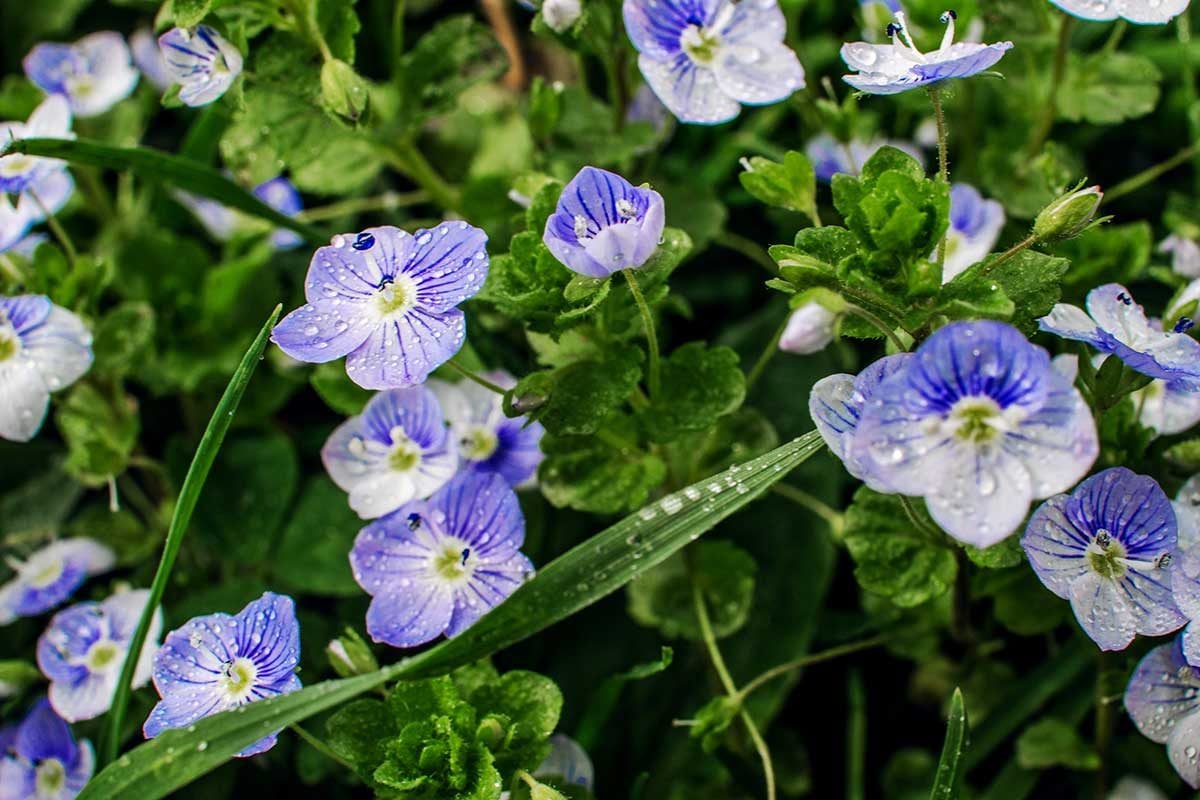Despite its pretty blue flowers, too much speedwell can be an eyesore on an otherwise tidy lawn. Here's how to keep it from taking over.

What Is Speedwell and How Do I Get Rid of It?

Speedwell is known for its bright blossoms that travelers crossing the open countryside would once tuck into their clothes as a charm to “speed one well,” or protect against mishaps during their journey. That’s how the plant got its cheery name.
With more than 500 species found across the globe, speedwell (AKA creeping Veronica, bird’s eye and gypsyweed) can be a desired ornamental or a pesky nuisance, depending upon where it pops up. This wildflower can be tricky to get rid of once it begins spreading across your lawn, so here are some tips to control its numbers.
On This Page
What Is Speedwell?
Speedwell is a low-growing broadleaf plant that spreads quickly and can cover an entire lawn if not kept in check. However, it generally does not completely crowd out turfgrass. It’s also an important source of nectar for hummingbirds and pollinating insects, which is why many homeowners tolerate a limited number of these wildflowers in their lawn.
There are many types of speedwell, but most share the same four-petaled blue or white flowers and heart-shaped seed pods. The seeds in the pods usually do not mature, so the plant almost never reproduces from seeds. Instead, this perennial reproduces via creeping runners that root at their nodes where they come in contact with the soil.
Is Speedwell a Weed?
Some species of speedwell are used as ornamental plants to liven rock gardens or border ornamental beds. Others, however, are considered weeds because they spread over lawns and can be a challenge to eradicate. The most common of these weed species include germander speedwell, creeping speedwell, corn speedwell, Persian speedwell and ivy leaf speedwell.
Is Speedwell Safe?
According to gardening expert Bryan McKenzie of The Bumper Crop Times, speedwell is edible for humans and pets, but eating too much may cause vomiting.
“In herbal medicine, speedwell is used as a tea component that can reduce asthma or allergy symptoms,” he says. “Though it’s an edible plant, I wouldn’t recommend consuming it for medical purposes without a doctor’s recommendation.”
How To Get Rid of Speedwell
Many weed species of speedwell have fine hairs covering the tops of their leaves, making them resistant to herbicides. Careful hand pulling is the most effective way to eradicate this wildflower from your lawn.
-
Hand pulling: Rake over the area around each speedwell plant to pull up the runners and roots, making it easier to remove them completely. Then dig out the entire speedwell plant with a garden trowel or weeding hoe, removing at least six inches of soil around the base of the plant to clear away all root fragments and broken stems. Place the plant and its debris in a trash bag for disposal so you don’t accidentally drop any root or stem pieces onto the soil, where they may take root again.
-
Chemical herbicides: Using toxic chemicals on your lawn to get rid of speedwell should be a last resort, as these can be harmful to children, pets and wildlife. Try spot-treating individual plants with a post-emergent broadleaf herbicide in the late spring or early summer when the plant is in its most active growing phase. For application, McKenzie says the best conditions are cool, moist and still. “You don’t want other plants to be affected, so there must be no rain at least three days after treatment,” he says.
How To Prevent Speedwell From Coming Back
Once you’ve completed the labor-intensive process of ridding your lawn of speedwell, make sure you won’t see their tiny blue blooms again come spring with these steps:
-
Lawn care best practices: Keep your lawn healthy to deter a speedwell invasion. Fertilize appropriately for your turfgrass and region, aerate the soil in the autumn and mow regularly. Speedwell thrives in moist, shady areas so make sure your lawn has adequate drainage and gets lots of sunlight.
-
Flower and seed pod removal: “If the plant is already on your lawn,” says MacKenzie, “carefully remove all the flower heads before they bloom and shed seeds on the ground. This way you will reduce the probability of speedwell’s growth next year to a minimum.”
-
Chemical herbicides: For serious infestations, you can use a pre-emergent broadleaf herbicide in the spring. Again, use with care. Herbicides may harm pets, children, pollinators and other wildlife, and applying to large areas also contaminates nearby groundwater.




















